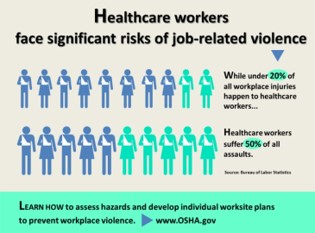Workplace assault is not something many healthcare workers anticipated when they initially signed up for the job, and nor should it be. According to the American Journal of Managed Care (AJMC), 75% of 25,000 workplace assault cases occur in the healthcare setting against workers. Most frequently, these outbreaks of violence occur in areas of the hospital which tend to higher acuity cases, such as the ED and ICU, but of course, are not limited [1].
According to the U.S. Bureau of Labor Statistics, workers in healthcare are five times more likely to experience injuries from workplace violence than any other work setting in the private sector. These occurrences are not arbitrary and have followed an escalating trend with incidence increased by 80% in the last decade. A poll conducted by the American College of Emergency Physicians in 2018 found that approximately half of respondent EM physicians reported being physically assaulted at least once in their career, with 60% stating attacks within the same year as the survey was done. In contrast, it has been noted that only approximately 30% of nurses and 26% of ED physicians have filed official reports of incidences of violence in the last year [2],[3].
Most reported cases consist of both verbal and physical abuse and are almost exclusively instigated by patients who are frustrated with staff or disoriented, or even family members in times of high stress. Cleveland Clinic CEO Tom Mihaljevic, MD, has labeled the issue of workplace violence as an epidemic. “There is a very fundamental problem in U.S. health that very few people speak about,” he states, “and that’s the violence against health care workers. Daily—literally, daily—we are exposed to violent outbursts, in particular in emergency rooms”. In response, all individuals entering the Cleveland Clinic ED today—and at an increasing number of facilities in the nation—are subject to screening through a metal detector. Cleveland Clinic officials have even disclosed their security protocol to include body scans with metal wands and personal item searches upon ED entry. The officials say they confiscate thousands of weapons each year through their emergency department alone—ranging from knives, pepper sprays, and firearms. The Cleveland Clinic has also administered other degrees of safety precautions, including wireless panic buttons attached to workers’ badges, increased safety cameras, and staffing of plainclothes officers in the ER [3].
Other hospitals across the nation have additionally reported attacks outside of emergency rooms. In one instance, a nurse at USC Keck Hospital in Los Angeles was caring for a patient in the neuro ICU when the patient broke free of his restraints and fully barraged the nurse with punches and kicks. The nurse was shaken and anxious when returning to work, days later. She commented on the attack saying she was afraid to report it. “It is expected that you are going to get beat up from time to time,” she stated [3].
Unfortunately, many providers claim these to be, “simply part of the job”. Many providers have spoken out on the issue and the low rate of reports, indicating that there is an unspoken code of silence. Michelle Mahon, a representative of the labor group of National Nurses United, reports, “In some cases, unfortunately, they [nurses and physicians] are treated as if they are the ones who don’t know how to do their job. Or that it’s their fault that this happened” [3].

Fortunately, last November, the U.S. House of Representatives passed a national bill drafted by Rep. Joe Courtney of Connecticut, H.R. 1309, the Workplace Violence Prevention for Health Care and Social Service Workers Act, which went through in a bipartisan vote. The bill would direct the Occupational Safety and Health Administration (OSHA) to establish requirements for the safety of workers as well as preventative measures for workers involved in violent attacks. OSHA has previously developed guidelines for employers and hospitals, but employers are surprisingly not required to follow them [2]. With the new plan in place, employers are obligated to investigate all workplace violence incidents, provide training and education regarding workplace violence hazards, and prohibit discrimination or retaliation against employees for reporting incidents, threats, or concerns. More specifically, it includes well-defined methods for prevention including physical changes to the environment, staffing for patient care and security, hands-on training sessions, robust record-keeping, and legal protections to employees. The legislation covers a wide variety of workplaces including large hospital settings, residential treatment facilities, non-residential treatment settings, treatment settings in correctional or detention facilities, psychiatric facilities, substance abuse treatment centers, federally operated facilities such as the VA, and community treatment settings [1],[4].
While many lobbying groups representing healthcare providers have approved of these initial movements towards violence prevention and protection, it is only a first step, and more needs to be done. Employees in healthcare deserve to feel safe in hospitals, clinics, and social service settings. After all, these are supposed to be places where healing occurs—not further damage.
[1] Stephens W. Violence Against Healthcare Workers: A Rising Epidemic. AJMC. https://www.ajmc.com/focus-of-the-week/violence-against-healthcare-workers-a-rising-epidemic. Accessed March 2, 2020. [2] Courtney J. Taking legislative action to reduce workplace violence in healthcare. Modern Healthcare. https://www.modernhealthcare.com/opinion-editorial/taking-legislative-action-reduce-workplace-violence-healthcare. Published January 14, 2020. Accessed March 2, 2020. [3] Harris-Taylor M. Facing Escalating Workplace Violence, Hospital Employees Have Had Enough. NPR. https://www.npr.org/sections/health-shots/2019/04/08/709470502/facing-escalating-workplace-violence-hospitals-employees-have-had-enough. Published April 8, 2019. Accessed March 2, 2020. [4] Prentiss S. House Passes Bipartisan Bill to Prevent Workplace Violence for Health Care and Social Services Workers. House Passes H.R. 1309 Workplace Violence Bill – American Trauma Society. https://www.amtrauma.org/news/479328/House-Passes-H.R.-1309-Workplace-Violence-Bill-.htm. Accessed March 2, 2020.
Aaron Tran is a member of The University of Arizona College of Medicine – Phoenix Class of 2023. He graduated from Arizona State University in 2018 with a degree in Kinesiology. In his spare time, he enjoys training Brazilian Jiu-jitsu, bodybuilding, playing guitar and piano, and hanging out with his labrador retriever, Rex, outdoors.
For questions, concerns, or discussion: atran13@email.arizona.edu


